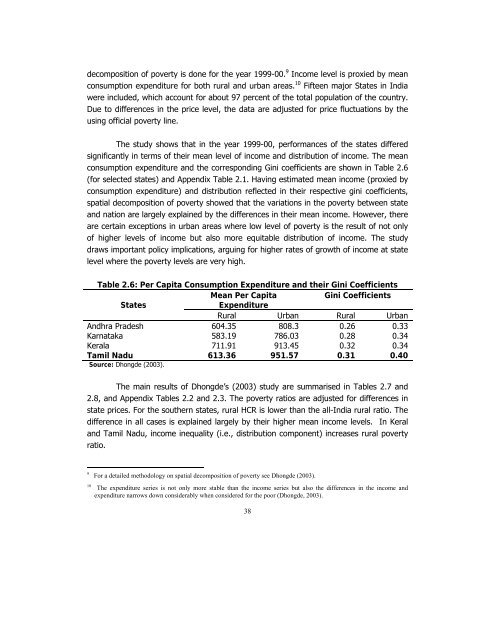POVERTY REDUCTION STRATEGY TN
You also want an ePaper? Increase the reach of your titles
YUMPU automatically turns print PDFs into web optimized ePapers that Google loves.
decomposition of poverty is done for the year 1999-00. 9 Income level is proxied by mean<br />
consumption expenditure for both rural and urban areas. 10 Fifteen major States in India<br />
were included, which account for about 97 percent of the total population of the country.<br />
Due to differences in the price level, the data are adjusted for price fluctuations by the<br />
using official poverty line.<br />
The study shows that in the year 1999-00, performances of the states differed<br />
significantly in terms of their mean level of income and distribution of income. The mean<br />
consumption expenditure and the corresponding Gini coefficients are shown in Table 2.6<br />
(for selected states) and Appendix Table 2.1. Having estimated mean income (proxied by<br />
consumption expenditure) and distribution reflected in their respective gini coefficients,<br />
spatial decomposition of poverty showed that the variations in the poverty between state<br />
and nation are largely explained by the differences in their mean income. However, there<br />
are certain exceptions in urban areas where low level of poverty is the result of not only<br />
of higher levels of income but also more equitable distribution of income. The study<br />
draws important policy implications, arguing for higher rates of growth of income at state<br />
level where the poverty levels are very high.<br />
Table 2.6: Per Capita Consumption Expenditure and their Gini Coefficients<br />
Mean Per Capita<br />
Gini Coefficients<br />
States<br />
Expenditure<br />
Rural Urban Rural Urban<br />
Andhra Pradesh 604.35 808.3 0.26 0.33<br />
Karnataka 583.19 786.03 0.28 0.34<br />
Kerala 711.91 913.45 0.32 0.34<br />
Tamil Nadu 613.36 951.57 0.31 0.40<br />
Source: Dhongde (2003).<br />
The main results of Dhongde’s (2003) study are summarised in Tables 2.7 and<br />
2.8, and Appendix Tables 2.2 and 2.3. The poverty ratios are adjusted for differences in<br />
state prices. For the southern states, rural HCR is lower than the all-India rural ratio. The<br />
difference in all cases is explained largely by their higher mean income levels. In Keral<br />
and Tamil Nadu, income inequality (i.e., distribution component) increases rural poverty<br />
ratio.<br />
9<br />
10<br />
For a detailed methodology on spatial decomposition of poverty see Dhongde (2003).<br />
The expenditure series is not only more stable than the income series but also the differences in the income and<br />
expenditure narrows down considerably when considered for the poor (Dhongde, 2003).<br />
38

















